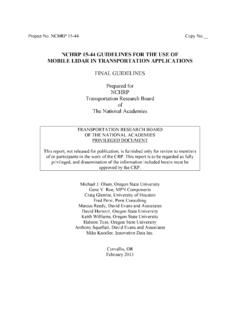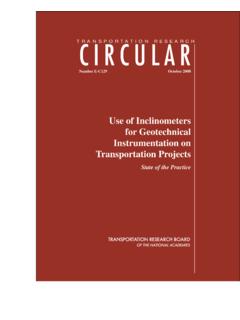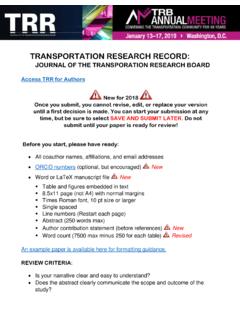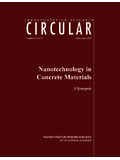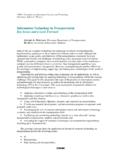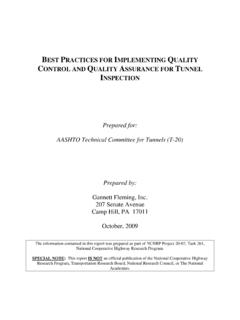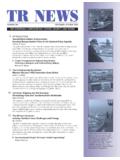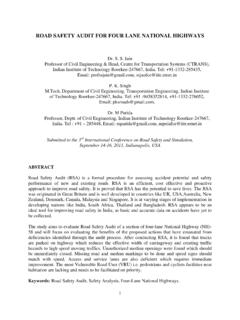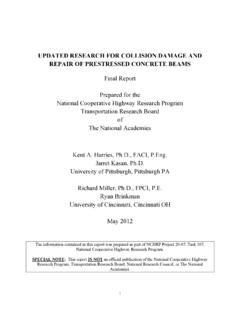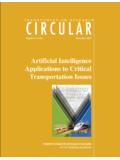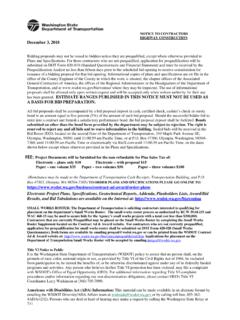Transcription of NCHRP Project 20-68A Scan 09-01 Best Practices In Quality ...
1 best Practices In Quality control And assurance In DesignNCHRP Project 20-68 AScan 09-01 Supported by theNational Cooperative Highway Research ProgramJuly 2011 The information contained in this report was prepared as part of NCHRP Project 20 68A Domestic Scan, National Cooperative Highway Research NOTE: This report IS NOT an official publication of the National Cooperative Highway Research Program, Transportation Research Board, National Research Council, or The National Practices IN Quality control AND assurance IN DESIGNA cknowledgmentsThe work described in this document was conducted as part of NCHRP Project 20-68A , the Domestic Scan program. This program was requested by the American Association of State Highway and Transportation Officials (AASHTO), with funding provided through the National Cooperative Highway Research Program ( NCHRP ). The NCHRP is supported by annual voluntary contributions from the state departments of transportation.
2 Additional support for selected scans is provided by the Federal Highway Administration and other agencies. The purpose of each scan and of Project 20-68A as a whole is to accelerate beneficial innovation by facilitating information sharing and technology exchange among the states and other transportation agencies, and identifying actionable items of common interest. Experience has shown that personal contact with new ideas and their application is a particularly valuable means for such sharing and exchange. A scan entails peer-to-peer discussions between practitioners who have implemented new Practices and others who are able to disseminate knowledge of these new Practices and their possible benefits to a broad audience of other users. Each scan addresses a single technical topic selected by AASHTO and the NCHRP 20-68A Project Panel. Further information on the NCHRP 20-68A Domestic Scan program is available at report was prepared by the scan team for Scan 09-01 , best Practices in Quality control and assurance in Design, whose members are listed below.
3 Scan planning and logistics are managed by Arora and Associates, P. C.; Harry Capers PE is the Principal Investigator. Hossein Ghara, PE, Louisiana DOT, AASHTO Co-ChairKelley C. Rehm, PE, Kelley Rehm Consulting, Principal AuthorNancy Boyd, Washington State DOTTim Swanson, Minnesota DOTC armen Swanwick, Utah DOTR obert J. Healy, PE, Maryland DOTR ichard W. Dunne, PE, New Jersey DOTR obert S. Watral, PE, Pennsylvania DOTD isclaimerThe information in this document was taken directly from the submission of the authors. The opinions and conclusions expressed or implied are those of the scan team and are not necessarily those of the Transportation Research Board, the National Research Council, or the program sponsors. This document has not been edited by the Transportation Research Practices IN Quality control AND assurance IN DESIGNScan 09-01 best Practices In Quality control And assurance In DesignPREPARED BYREQUESTED BY THEA merican Association of State Highway and Transportation OfficialsHossein Ghara, , Louisiana DOT, AASHTO Co-Chair Kelley C.
4 Rehm, , Kelley Rehm Consulting, Principal Author Nancy Boyd, Washington State DOT Tim Swanson, Minnesota DOT Carmen Swanwick, Utah DOT Robert J. Healy, , Maryland DOT Richard W. Dunne, New Jersey DOT Robert S. Watral, , Pennsylvania DOT Arora and Associates, , NJJuly 2011 SCAN MANAGEMENTThe information contained in this report was prepared as part of NCHRP Project 20 68A Domestic Scan, National Cooperative Highway Research NOTE: This report IS NOT an official publication of the National Cooperative Highway Research Program, Transportation Research Board, National Research Council, or The National Practices IN Quality control AND assurance IN DESIGNT able of ContentsAbbreviations and VIIE xecutive ES-1 ES-1 Common Practices .. ES-2 Training and Well-Developed Communication Channel ..ES-3 Drivers to Document QC/QA Processes .. ES-3 Common Review and Approval ES-4 Summary of Initial Findings and ES-4 Overall Successful ES-4 Checklists, Manuals and Scoping and ES-5 Value Engineering ES-5 Consultant Selection and ES-6 Construction Reviews and ES-6 Quality in Existing ES-6 Future ES-6 Planned Implementation Overview and 1-1 Study Focus 1-2 Study Organization and 1-2 Scan Team 1-4 Findings and 2-1 Quality Host States Organization Host States Bridge Office and Highway Design Office 2-3 2-3 Georgia.
5 2-4 2-4 2-4 2-5 New 2-5 IITABLE OF CONTENTS 2-5 2-6 2-6 Washington 2-6 Host State Program 2-6 Percentage of Designs Completed In-House or by Successful 3-1 3-1 What Is a Successful State?.. 3-1 Common Elements Among Host 3-1 Training and Communication Training Rotations and Staff 3-3 New 3-3 3-3 3-4 3-4 Reporting and 3-5 Georgia .. 3-5 3-5 New Regularly Scheduled Meetings Across 3-8 Relationships Between Consultants and the 3-9 3-9 3-11 3-11 Review and Approval Value 3-12 Third Party 3-13 Plan Review and 3-15 3-15 Georgia .. 3-16 New 3-16 Single-Point Data 3-17 IIIBEST Practices IN Quality control AND assurance IN DESIGN 3-17 3-17 Checklists, Manuals, and 3-18 3-18 Separate Divisions for 3-20 3-20 New 3-21 Special Design-Build: Unique Delivery Methods: 3-23 Scoping and Environmental 3-24 Early Involvement of All 3-25 Funded Positions at Regulatory 3-26 Environmental Commitment 3-27 Consultant Selection and Consultant QC/QA Construction Reviews and Construction Feedback and Post-Construction 3-31 New 3-31 3-32 Quality in Existing 3-35 Effectiveness and Efficiency in Existing 3-35 4-1 Team 4-1 Future.
6 4-1 Implementation . 4-1 IVTABLE OF CONTENTSList of Appendices Appendix A: Scan Team Biographical B: Scan Team Contact C: Host Agency C-1 Appendix D: Amplifying Questions and Desk Scan D-1 Appendix E: State Forms and E-1 List of FiguresFigure States included in the 1-3 Figure Caltrans contract Quality management 3-6 Figure KYTC GIS lessons learned database 3-12 Figure PennDOT QC 3-15 Figure Georgia plan title 3-16 Figure Georgia in-house review 3-16 Figure Quality flowchart for design 3-19 Figure KYTC highway design organizational 3-20 Figure PennDOT design organizational 3-21 Figure NYSDOT Design QA Bureau organizational 3-22 Figure GDOT green sheet (actually printed on green paper) 3-27 Figure GDOT environmental impact table 3-28 Figure QC/QA requirements of consultants doing bridge 3-29 Figure Mn/DOT consultant Quality plan evaluation 3-30 Figure Average recent responses to NYSDOT s bid-ability evaluation 3-31 Figure Example KYTC post-construction review fact 3-32 Figure KYTC GIS database screen shot of post-construction 3-33 Figure KYTC GIS database screen shot of post-construction 3-34 Figure Example analysis from KYTC GIS post-construction review 3-34 VBEST Practices IN Quality control AND assurance IN DESIGNList of TablesTable Scan team 1-4 Table SAFETEA-LU estimated highway apportionments from 2005 2-7 Table Bridges and highways designed either in-house or by 2-7 Table Caltrans projects selected for IA 3-6 Table Oregon s 12-step Quality process 3-36 ABBREVIATIONS AND ACRONYMSVIIBEST Practices IN Quality control AND assurance IN DESIGNAASHTO American
7 Association of State Highway and Transportation OfficialsACEC American Council of Engineering CompaniesAGC American General ContractorsCaltrans California Department of TransportationDOT Department of TransportationFHWA Federal Highway AdministrationGDOT Georgia Department of Transportation GIS Geographic Information SystemIA Independent Quality assurance (Caltrans)IDOT Illinois Department of TransportationISO International Organization for StandardizationKYTC Kentucky Transportation CabinetMn/DOT Minnesota Department of TransportationNCHRP National Cooperative Highway Research ProgramNTSB National Transportation Safety BoardNYSDOT New York State Department of TransportationOBDP Oregon Bridge Delivery PartnersODOT Oregon Department of Transportation or Ohio Department of TransportationOTIA III Oregon Transportation Investment Act III State Bridge Delivery ProgramPE Professional EngineerPennDOT Pennsylvania Department of TransportationPM Project ManagerPQAR Project Quality assurance Report (NYSDOT)
8 PS&E Plans, Specifications, and EstimatesQC/QA Quality control / Quality assurance Abbreviations and AcronymsVIIIABBREVIATIONS AND ACRONYMSTRB Transportation Research BoardVE Value EngineeringVECP Value Engineering Change ProposalsWSDOT Washington State Department of TransportationEXECUTIVE SUMMARYES-1 best Practices IN ADDRESSING NPDES AND OTHER WATER Quality ISSUES IN HIGHWAY SYSTEM MANAGEMENTE xecutive SummaryOverviewOn Wednesday, August 1, 2007, at approximately 6:00 , the I-35W highway bridge over the Mississippi River in Minneapolis, Minnesota, experienced a catastrophic failure. As a result, 1,000 feet of the deck truss collapsed. The National Transportation Safety Board (NTSB) immediately began an investigation into the cause of the collapse. The investigation eventually determined that the collapse of the I-35W bridge initiated with the failure of the gusset plates at the U10 nodes on the following safety issue, among others, was identified in the investigation:Insufficient bridge design firm Quality control procedures for designing bridges, and insufficient Federal and State procedures for reviewing and approving bridge design plans and calculations.
9 (NTSB, Nov. 2008).This finding lead the NTSB to recommend to the Federal Highway Administration (FHWA) and the American Association of State Highway and Transportation Officials (AASHTO) that the two organizations work together to develop a more adequate program of Quality control and assurance (QC/QA or QA/QC) in bridge design to be used by the states and other bridge owners. The NTSB recommended that this Quality program include procedures to detect and correct bridge design errors before the design plans are made final. In response to this recommendation, AASHTO initiated a study to provide a synthesis of current state department of transportation (DOT) Practices for QC/QA in the area of bridge design and plan review. This domestic scan was initiated following the NTSB recommendation to build on the initial AASHTO studies. The scope of this scan was expanded to incorporate aspects of Quality programs in highway design, bridge design, overall Project delivery, and QC/QA for special contract projects, such as design-build.
10 The scan team believes that it is important to look at overall Project Quality , rather than just focus on bridge design, since there are farther-reaching Quality issues, such as higher numbers and greater costs of change orders. Finally, the scan team also investigated the QC/QA Practices encompassing Project programming and planning stages, environmental permitting, and highway and bridge design. The team also examined lessons-learned feedback loops through preliminary analysis conducted through a desk scan refined the list of states based on the size of their programs, the region of the country, the nature of their organization ( , decentralized, centralized, and percent of work done by consultants) and innovative Practices in QC/QA. The team chose the following states for visits because of innovative or standout QC/QA programs:ES-2 EXECUTIVE SUMMARYn New Yorkn Pennsylvanian Kentuckyn Minnesotan Georgian Oregonn CaliforniaIn addition, the team held separate meetings and teleconferences with the following states to discuss specific components of their QC/QA programs:n Ohion Washington Staten IllinoisThe scan team developed amplifying questions and sent them to the selected agencies before the visit to allow the host agencies to center their preparations on the specific areas of interest to this scan topic.
